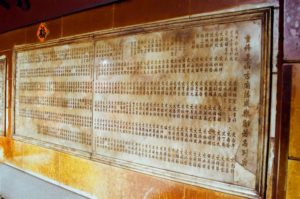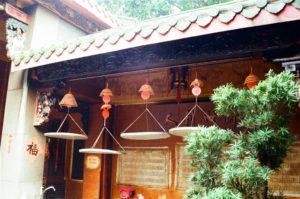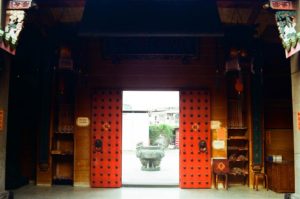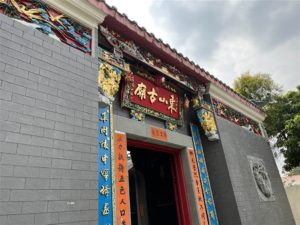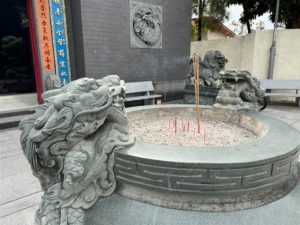Of the Man’s – The Tung Shan Temple in San Tin, Yuen Long
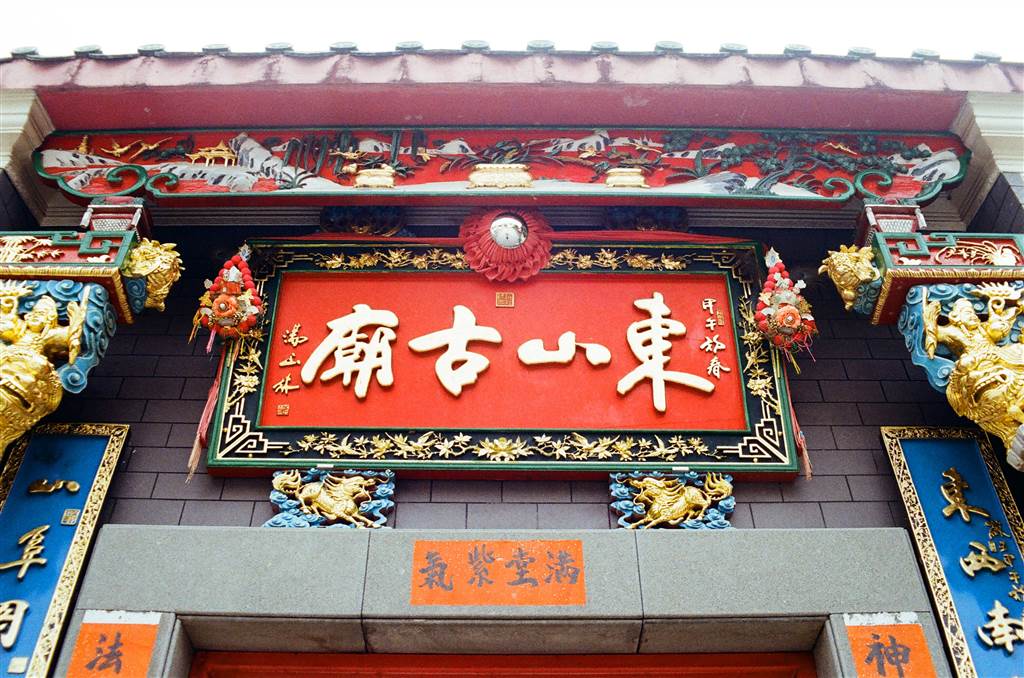
The Tung Shan Temple is an easily accessible site in San Tin, Yuen Long. It lies right at the village entrance, next to the restaurants of San Tin. I have seen signs pointing to the temple and finally had the opportunity to pay a visit. It has quite an unusual beauty as a temple.

History
Along with the Tang, Hau, Pang and Liu clans, the Man’s were recognized as one of the “five great clans” of the New Territories by the colonial government of Hong Kong. Scholars have suggested that the colonial government made favorable policies for them because of their joined resistance against the British takeover of the New Territories during the Six-day War of 1899. The main clan residing in the San Tin area is the Man’s.
Tung Shan is the name of Man Tin-shui, the descendants of whom established the Man villages in San Tin of Yuen Long. Originally, Tung Shan Temple was a Tin Hau Temple. After its restoration in 1905, the temple was dedicated to the original ancestor Man Tin-shui, as such it acquired the name Tung Shan Temple.
The Tung Shan Temple of San Tin became a Grade 3 historic building in 2010. It is believed that its earliest existence began during the Chenghua Reign of Ming Dynasty (1470). Man Sai Kor, who was also the founder of the Man villages in San Tin (see below), founded this temple. As such, the temple prides a history of more than five hundred years. The former structure was restored during the Guangxu Reign of the Qing Dynasty (1905). It underwent a restoration in 1970. Finally, the former structure was rebuilt in 2013, with most of the items replaced.
Photos: Items inside the temple. The plaques on the two photographs on the left show the details and contributors to the restorations.
The Man’s of San Tin shares the same lineage with Wen Tianxiang (pinyin), who was a very famous historical figure in China’s ancient times. He was the prime minister (standing on the right side of the Emperor, as the highest-ranked official during the Southern Song Dynasty) for the Song Emperor. He was a loyal politician and also a poet. History books laud him for staunchly opposing the forces of Kublai Kahn, leader of the non-Han Mongolian tribe, who would establish the Yuan Dynasty after Song Dynasty fell.
Kublai Khan’s forces captured Wen Tianxiang in 1278, and offered Wen a post as an official in the imperial court of Kublai Khan. Wen refused to succumb to the “barbaric mongols,” and suffered greatly for four years in prison. He was eventually executed, but left behind a great patriotic poem known as the Songs of Righteousness for posterity.
Now, the Man’s of the New Territories were not direct descendants of Wen Tianxiang, but they do take pride in the shared lineage with this peerless hero in Chinese history. The founding father of the Man’s in San Tin, Man Sai Kor, was a descendant of Man Tin-shui. Man Tin-shui was Wen Tianxiang’s cousin on the paternal line. Man Tin-shui himself was a noted official, although in no way as famous as Wen Tianxiang. He served in Guangdong during the Song Dynasty. His descendants ended up establishing a number of villages in various locations in the New Territories, including Tai Po and San Tin.
The Visit
When I arrived at the site, I came from the back of the temple then onto the front. I simply did not expect to see the grand appearance of the temple. I was very much amazed by how well-restored it was.
Tung Shan Temple: Views from the inside.
First of all, no one can miss the beautiful wooden plaque right at the entrance. The name of the temple in gold sets against a red background. This color combination really accentuates the words. The red, blue and gold theme conveys a brilliance and liveliness unusual for the temples of Hong Kong.
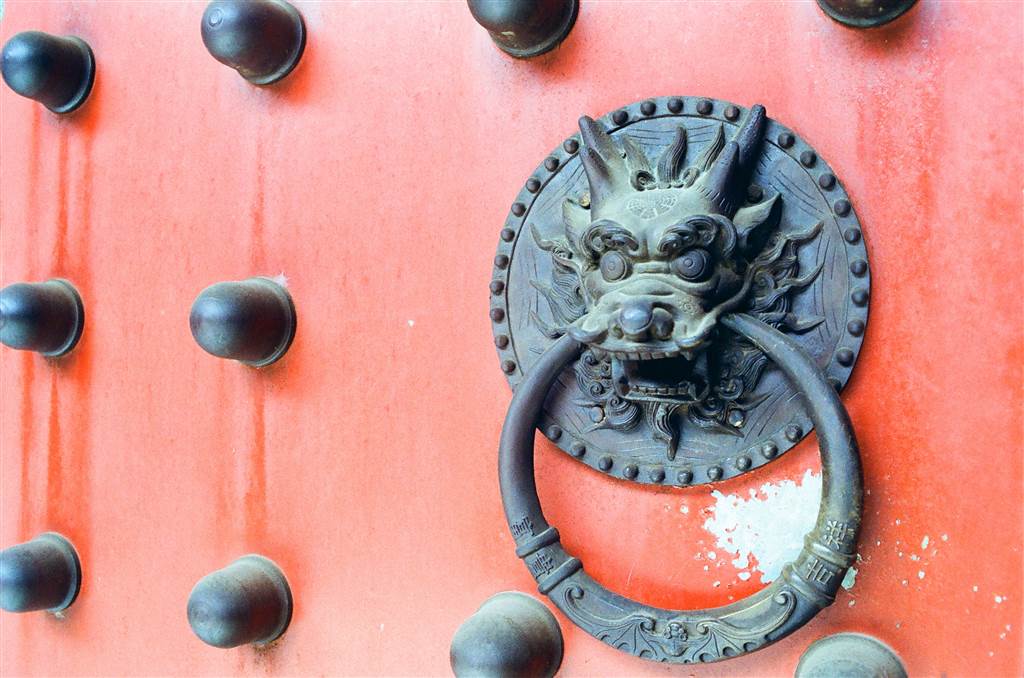
Figures of dragons, lions and an array of other auspicious animals greet visitors, giving an impression of authority. Right away, I straightened my back and prepared myself for a solemn entry.
According to a report online, the villagers did not think so highly of the Tung Shan Temple. They thought that the temple did not have good feng-shui, and the incense-burning turned cold there for a long time. I suspect the abundance of auspicious motifs are there to turn the feng-shui around.

Finally, also exceptionally beautiful are the figurines that line the top of Tung Shan Temple’s roof. These ones seemed to depict scenes of Chinese folktales. I wish I could tell what narratives they are.

Suggestions
First of all, I do think quite highly of the homey restaurants that line the entrance of the Wing Ping Tsuen Village in San Tin. They are right by the bus stop and offer good food with very reasonable prices. It is a good idea to stop there for a regular or a light meal.
Secondly, there are quite a number of heritage sites in this area. The best-known is Tai Fu Tai, which is a Qing Dynasty mansion for Man Chung-luen, the 21st generation ancestor for the Man clan in San Tin.
Last, but certainly not least, there are other sites. The Man Lun-fung Ancestral Hall, the Man Ancestral Hall and the Man San Ye Ancestral Hall lie in proximity within the Fan Tin Tsuen village. They are testaments to the Man clan’s history in the area. The Man Lun-fung Ancestral Hall has a notable scholarly bent to it, and I will explain in another entry.
Further Reading
This is part of the series on the Man clan’s history in San Tin, Yuen Long. See also the entries on Tai Fu Tai and Man Lun Fung Ancestral Hall. Consider doing all these sites in one trip. It is doable within a half day.
How to Get There
The easiest way by public transport is to take bus 76K from either Yuen Long Station (Yoho Mall 1) or Sheung Shui Station. The location is perhaps somewhat halfway between Sheung Shui and Yuen Long. Get off at the San Tin stop (note that it is the same stop for both directions, therefore watch out for which direction the bus is going when you leave). The Tung Shan Temple is right at the bus stop.
By private car, you may park at the small parking lot next to the San Tin Post Office but it is usually very crowded there.
Sources
Baidu.com.hk, Prime Minister on the Right.
The Wikipedia on Wen Tianxiang.
Chan Tin-kuen, The Ancestral Heritage of the Man Clan in San Tin, Yuen Long, Thinkhk.com (Chin), April 6, 2017.
Hugh D. R. Baker, The Five Great Clans of the New Territories, 6 Journal of the Hong Kong Branch of the Royal Asiatic Society 25-48 (1966), From the Wikipedia’s entry on the Five Great Clans of the New Territories.

